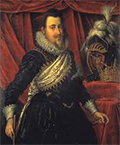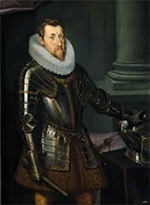The Thirty Years War
Part 2: An Ever-widening Conflict
Spain was already involved in a war in northern Europe. Parts of the Spanish Netherlands had revolted in 1568. The northern provinces formed the Dutch Republic, which took a leading role in opposing Spain and, in effect, Catholic forces during the Thirty Years War. In the summer of 1619, Bohemian rebels deposed Ferdinand II as their leader and handed the crown of their kingdom to Frederick V of the Palatinate (son of the late Frederick IV). Ferdinand might have been indifferent to this fact because he had by that time been elected Holy Roman Emperor. As the fighting progressed, other countries joined in; in the east, Polish troops fought for the Catholic cause. One non-Christian element of the early part of the war was the alliance of the Ottoman Empire with the Protestant Union. Ottoman infantry and cavalry battled against Polish forces but withdrew after defeat in 1621. Other European nations were helping with money and manpower. Elizabeth Stuart, the oldest child of England's King James I, was the husband of Frederick V, the Elector of the Palatinate, and so both England and Scotland (for James was also that country's King James VI) had loaned money to the Protestant side and sent troops to the front lines. Another country sending money to the Protestants was Denmark-Norway, whose leader, Christian IV, was a Lutheran and was also Duke of Holstein, a state within the Holy Roman Empire. Catholic forces had much early success, and Ferdinand was soon in control of much of northern Europe. One significant victory for the Catholic side was at the Battle of White Mountain, in 1620. Ferdinand II's troops routed Protestant forces under Frederick V and seized control of Bohemia and the Palatinate. The war intensified in the neighboring Spanish Netherlands, and Catholic successes continued. 
King Christian IV (right) led Danish troops into the war in 1625. Another significant Catholic victory, at Stadtlohn in 1623, had resulted in a short-term peace. Christian felt threatened by the advances made by imperial forces and, bolstered by troops from England and Scotland, renewed the fighting. The beneficiary of very bad timing, Christian soon found that allies that he was counting on had fallen by the wayside. Nearby Brandenburg and Saxony were too busy keeping the peace to jump back into the fighting, and the English troops struck delays in arriving. At the same time, Catholic forces got a strong new ally in the form of the Bohemian noble Albrecht von Wallenstein, who had a large army and led it into victory against Danish troops at Dessau Bridge in 1626. Johann Tserclaes, Count of Tilly, the victor at White Mountain, was still winning battles, forcing Danish troops back at Lutter a few months later. Wallenstein took the fight to Denmark itself, seizing Jutland; unable to seize Copenhagen, he broke off the attack and besieged the Baltic port of Stralsund, to prevent Christian's fleet reinforcement. The fighting exhausted both sides, and Christian and Wallenstein agreed in 1629 to the Treaty of Lübeck, by which Christian agreed to give up his holdings within the Holy Roman Empire. As the war dragged on, more and more of the countryside, primarily in the German states, lay in ruins. Such geographical constraints made the transfer of men and weapons slower than they otherwise might have been. This, in turn, gave cities not yet attacked more of an opportunity to build up their defenses, not only through their own efforts but also because enemy troops were moving more slowly in the field. Next page > Peace at Last > Page 1, 2, 3 |
|
Social Studies for Kids
copyright 2002–2026
David White



 Catholics and Protestants had been trading accusations and blows since the Reformation had begun, in the early 16th Century. When the Thirty Years War began, the two opposing sides were largely congregated based on their religious preference. To the aid of the Bohemian rebels came more Protestants, from the Union states in what is now Germany. To the aid of Archduke Ferdinand II (left) came his nephew, the powerful
Catholics and Protestants had been trading accusations and blows since the Reformation had begun, in the early 16th Century. When the Thirty Years War began, the two opposing sides were largely congregated based on their religious preference. To the aid of the Bohemian rebels came more Protestants, from the Union states in what is now Germany. To the aid of Archduke Ferdinand II (left) came his nephew, the powerful 
